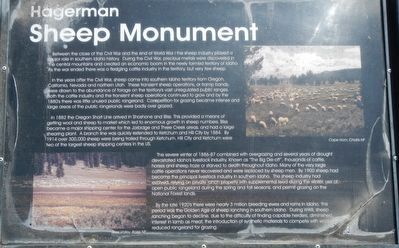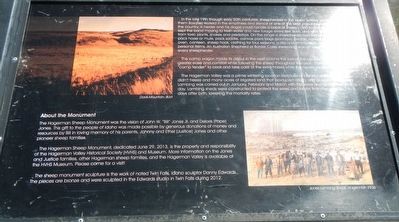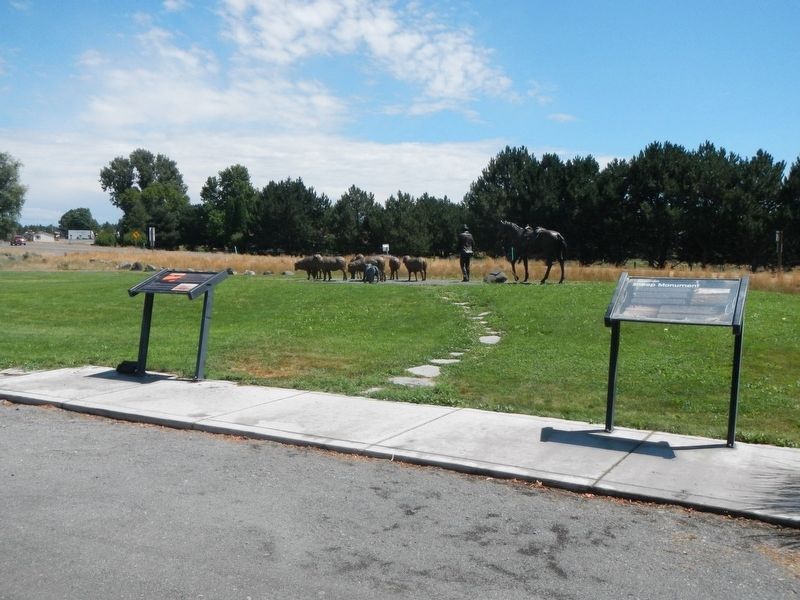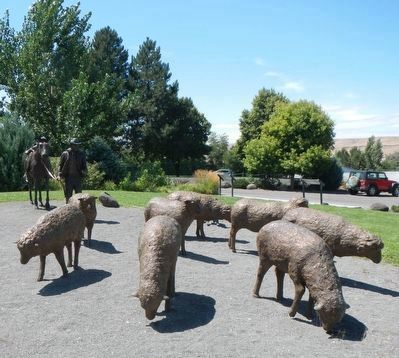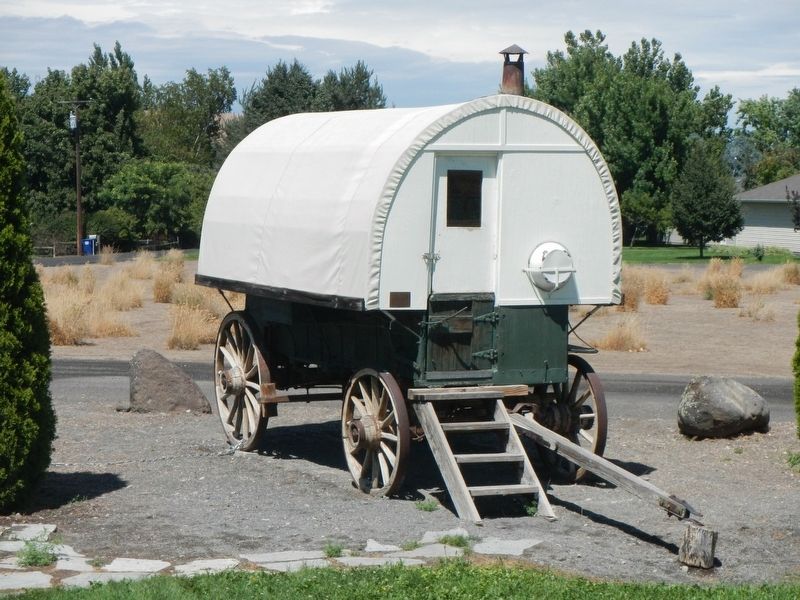Hagerman in Gooding County, Idaho — The American West (Mountains)
Hagerman Sheep Monument
Between the close of the Civil War and the end of World War I the sheep industry played a major role in southern Idaho history. During the Civil War, precious metals were discovered in the central mountains and created an economic boom in the newly formed territory of Idaho. As the war ended there was a fledgling cattle industry in the territory, but very few sheep.
In the years after the Civil War, sheep came into southern Idaho territory from Oregon, California, Nevada and northern Utah. These transient sheep operations, or tramp bands, were drawn to the abundance of forage on the territory's vast unregulated public ranges. Both the caste industry and the transient sheep operations continued to grow and by the 1880's there was little unused public rangeland. Competition for grazing became intense and large areas of public rangeland were badly over grazed.
In 1882 the Oregon Short Line arrived in Shoshone and Bliss. This provided a means of getting wool and sheep to markers which lead to enormous growth in sheep numbers. Bliss became a major shipping center for the Jarbridge and Three Creek areas, and had a large shearing plant. A branch line was quickly extended to Ketchum and Hill City by 1884. By 1914 over 300,000 sheep were being trailed through Ketchum. Hill City and Ketchum were two of the largest sheep shipping centers in the U.S.
The severe winter of 1886-87 combined with over grazing and several years of drought devastated Idaho's livestock industry. Known as "The Big Die-off," thousands of cattle, horses and sheep froze or starved to death throughout Idaho.Many of the very large cattle operations never recovered and were replaced by sheep men. By 1900 sheep had become the principal livestock industry in southern Idaho. The sheep industry had evolved, relying on private ranches with supplemental feed during the winter, use of open public rangeland during the spring and fall seasons, and permit grazing on National Forest lands.
By the late 1920's there were nearly 3 million breeding ewes and rams in Idaho. This period was the Golden Age of sheep ranching in southern Idaho. During World War II, sheep ranching began to decline, due to the difficulty of finding capable herders, diminished interest in lamb as meat, the introduction of synthetic materials to compete in wool reduced rangeland for grazing.
(second panel:)
In the late 19th through early 20th centuries, sheepherders in the Idaho Territory (a majority of the Basque) worked in the emptiness and silence of one of the least populated regions of the country. A herder and his dog(s) could handle a band of sheep (1500 to 2000 sheep). They kept the band moving to fresh water and new forage every few days, and kept them away from toxic plants, snakes and predators. On the range a sheep herder had with him a tent, a pack horse or mule, pack saddles, canvas pack bags (panniers), bedroll, canvas tarp, a Dutch oven, canteen, sheep hook, clothing for four seasons, a rifle and ammunition, and a few personal items. An Australian Shepherd or Border Collie sheepdog was an essential partner for every sheepherder.
The camp wagon made its debut in the west around the turn of the century. It provided for greater ease and comfort while following the sheep throughout the year. Camps now had a "camp tender" to cook and take care of the extra horses while the herder tended the sheep.
The Hagerman Valley was a prime wintering location because of plentiful spring water that didn't freeze and many acres of irrigated land that produced alfalfa and grain for winter feed. Lambing was carried out in January, February and March with the ewes and lambs fed twice a day. Lambing sheds were constructed to protect the ewes and lambs from the cold for 1 to 3 days after birth, lowering the mortality rates.
About the Monument
The Hagerman Sheep Monument was the vision of John W. "Bill" Jones, Jr. and Deloris (Pope) Jones. This gift to the people of Idaho was made possible by generous donations of money and resources by Bill in loving memory of his parents Johnny and Ethel (Justice) Jones and other pioneer sheep families.
The Hagerman Sheep Monument, dedicated June 29, 2013, is the property and responsibility of the Hagerman Valley Historical Society (HVHS) and Museum. More information on the Jones and Justice families, other Hagerman sheep families and the Hagerman Valley is available at the HVHS Museum. Please come for a visit!
The sheep monument sculpture is the work of noted Twin Falls, Idaho sculptor Danny Edwards. The pieces are bronze and were sculpted in the Edwards studios in Twin Falls during 2012.
Erected by Hagerman Valley Historical Society.
Topics. This historical marker and monument is listed in this topic list: Agriculture. A significant historical date for this entry is June 29, 2013.
Location. 42° 49.349′ N, 114° 53.895′ W. Marker is in Hagerman, Idaho, in Gooding County. Marker is at the intersection of South 950 East and North State Street on South 950 East. Touch for map. Marker is in this post office area: Hagerman ID 83332, United States of America. Touch for directions.
Other nearby markers. At least 8 other markers are within 5 miles of this marker, measured as the crow flies. Woody's Cove / The Hagerman Valley (approx. 2.4 miles away); History of the Malad River (approx. 3 miles away); The Malad Springs (approx. 3.7 miles away); Formation of Malad Gorge (approx. 3.7 miles away); Where are the Fossils? (approx. 4.3 miles away); "The People" (approx. 4.3 miles away); A Changing Climate (approx. 4.3 miles away); Sediments and Fossils (approx. 4.3 miles away). Touch for a list and map of all markers in Hagerman.
Credits. This page was last revised on September 15, 2019. It was originally submitted on September 15, 2019, by Barry Swackhamer of Brentwood, California. This page has been viewed 306 times since then and 20 times this year. Photos: 1, 2, 3, 4, 5. submitted on September 15, 2019, by Barry Swackhamer of Brentwood, California.
